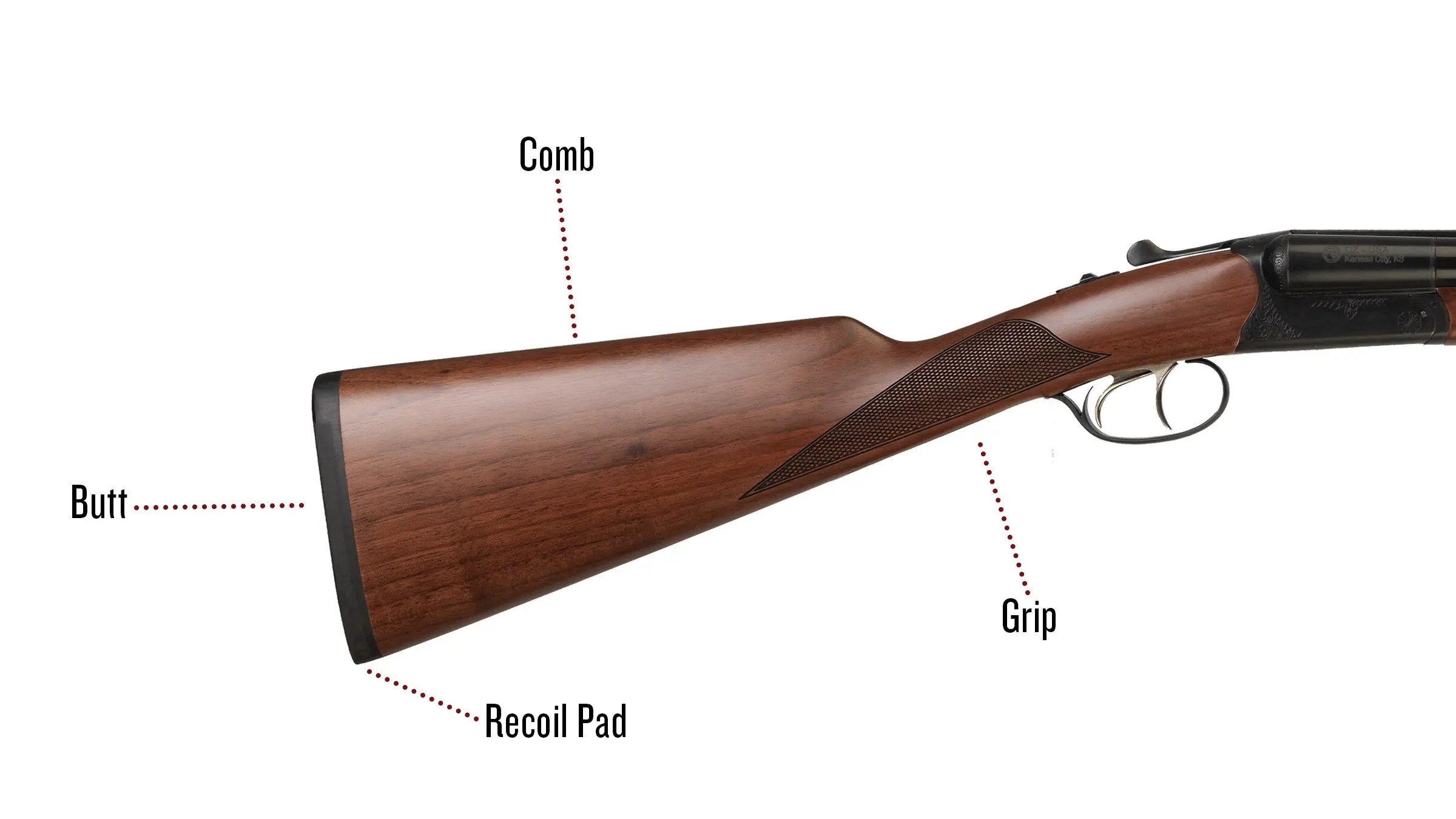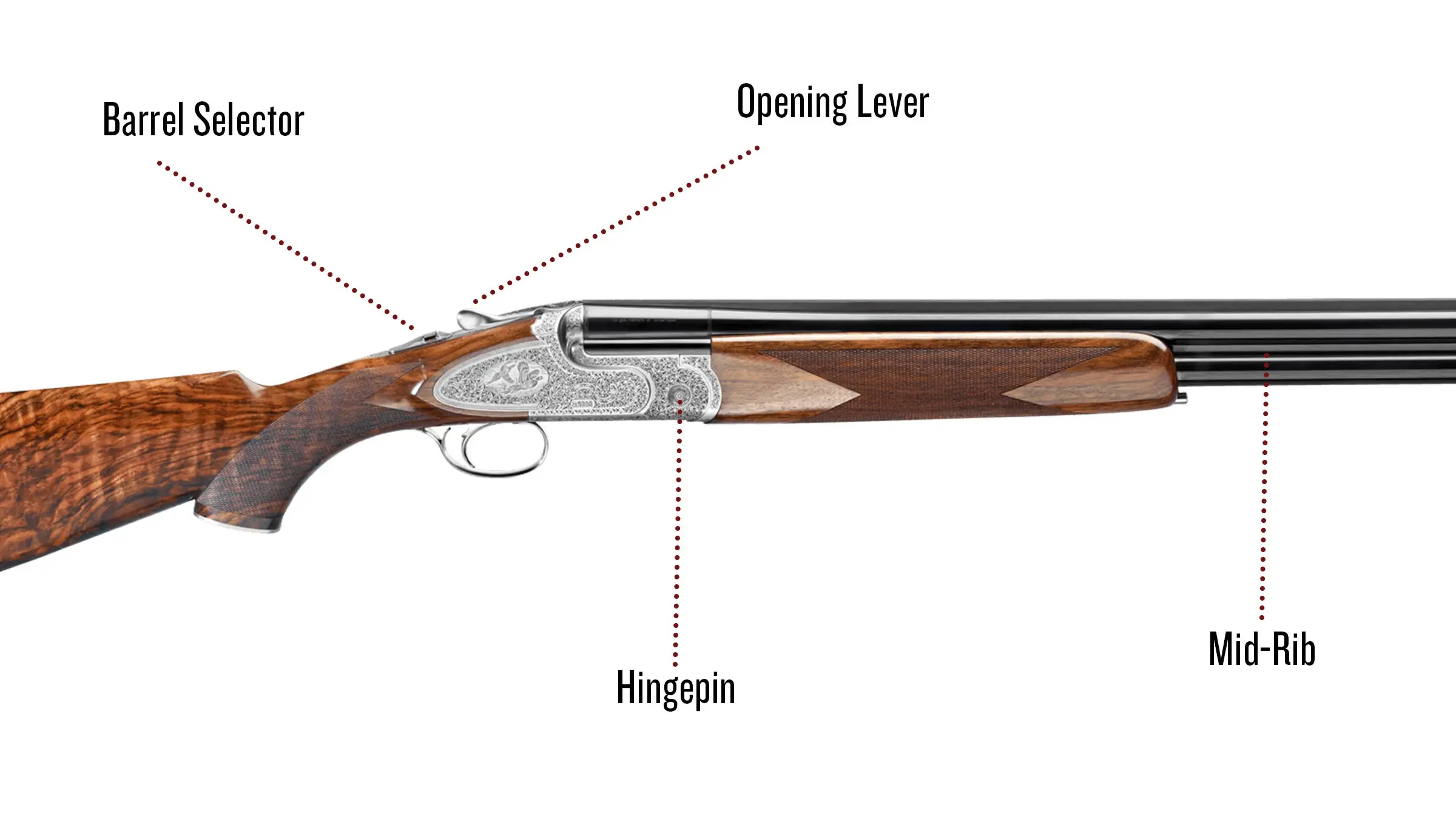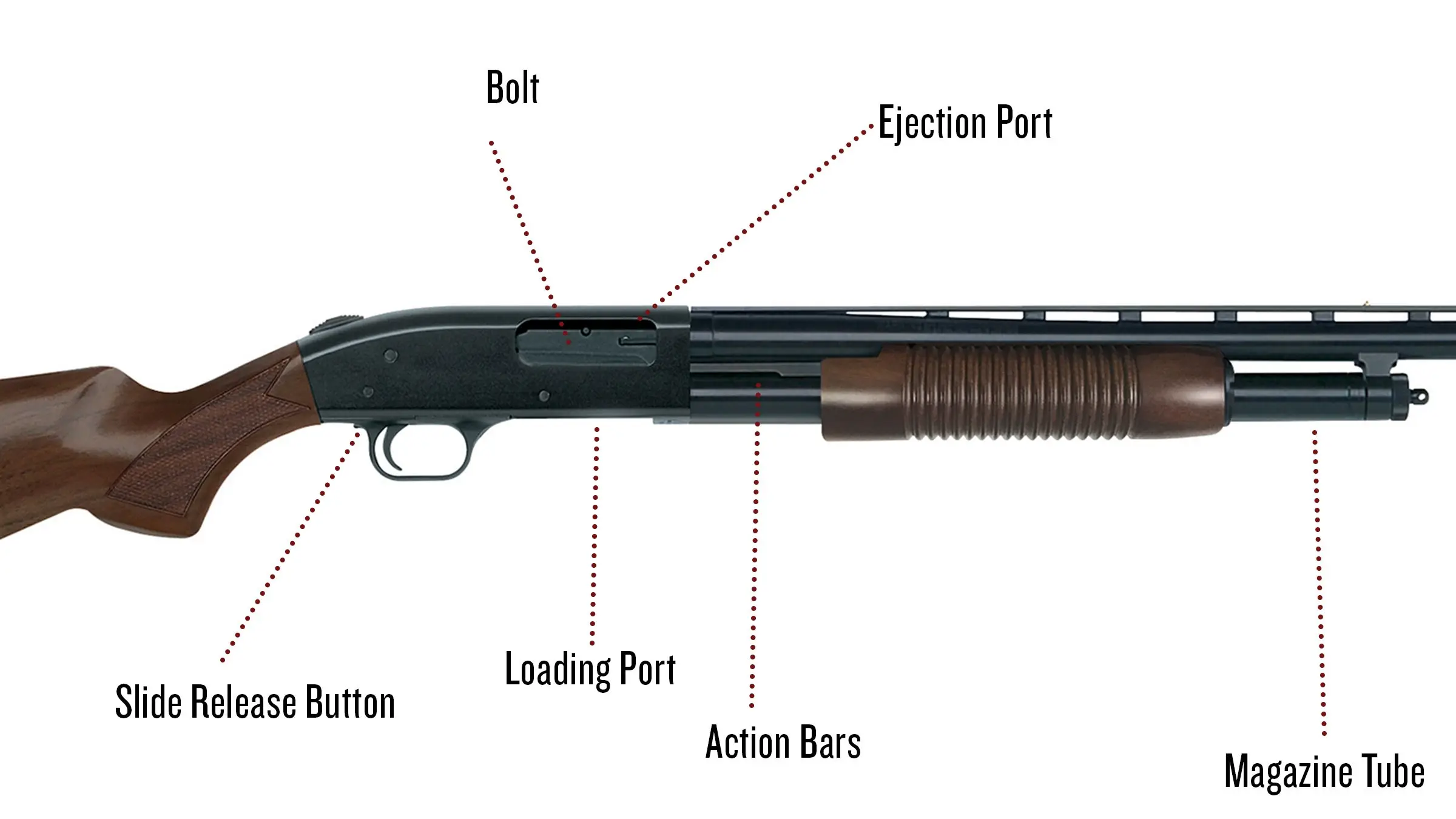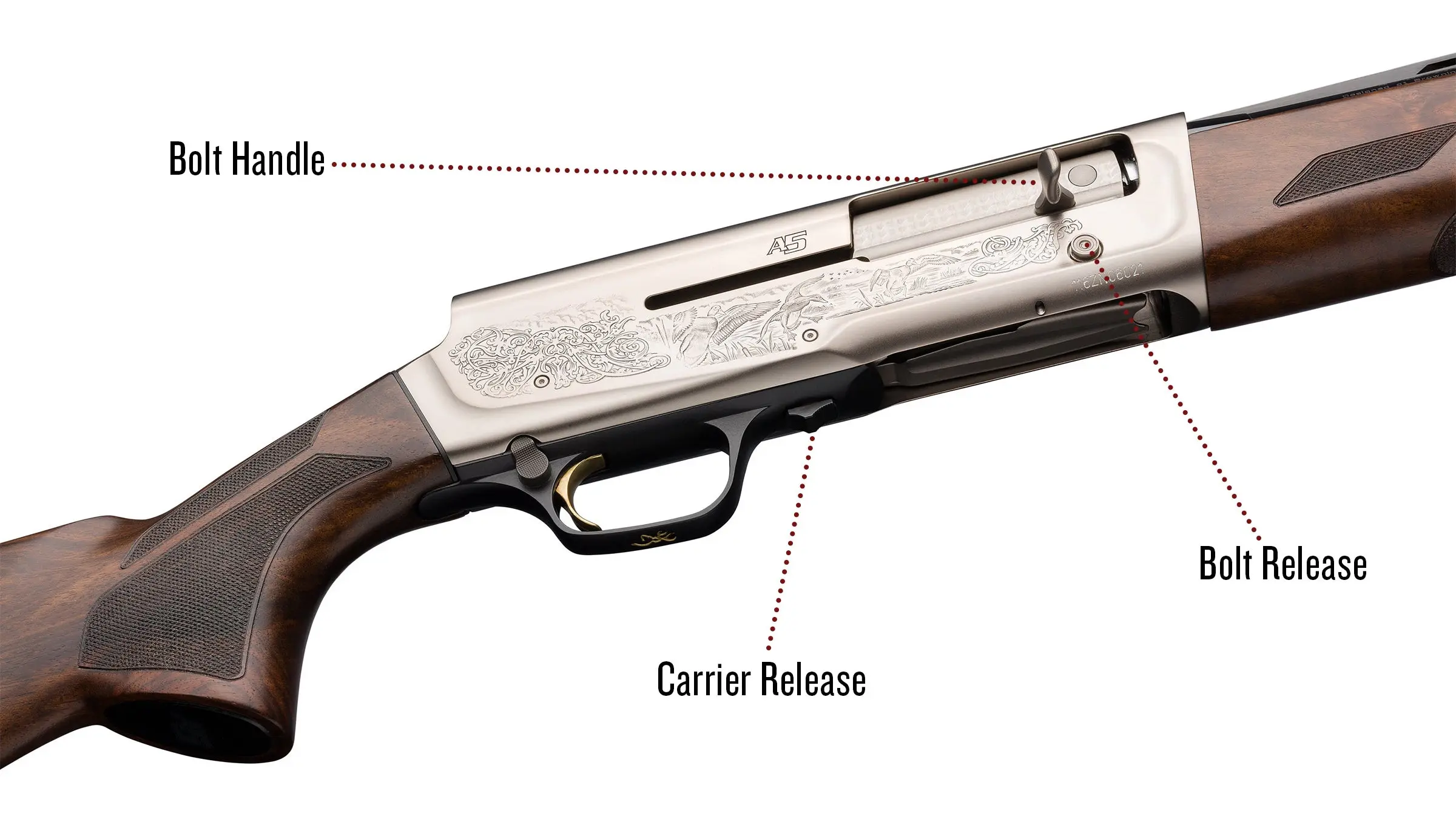We may earn revenue from the products available on this page and participate in affiliate programs. Learn more ›
A shotgun has to shoot where you look, reload quickly, and operate intuitively. The parts of a shotgun, the lock, stock, and barrel, all have their roles to play in the gun’s ease of use and handling qualities. Understanding the parts that make up a shotgun and what their functions are can help you make the very individual decision of which gun will work best for you.
Table of Contents
Parts of a Shotgun that all Action Types have in Common
Parts of a Shotgun Particular to Break Actions
Parts of a Shotgun Particular to Pump Actions
Parts of a Shotgun Particular to Semiautomatic shotguns
Shotgun Parts that all Action Types have in Common
Shotguns come in three main types: break-action, pump or slide-action, and semiautomatic. All of them share several parts in common so we’ll cover those first.
Barrel: Shotguns have one, two, or very occasionally, three barrels. Each shotgun gauge has its nominal diameter. For instance, a 12-gauge’s nominal bore is .729 inches. Some barrels are “overbored” to larger diameters, which, in theory, improves patterns and reduces recoil. Barrels come in different lengths, too. In general, longer barrels are better for smooth swings and steadiness and are found on target and waterfowl guns. Shorter barrels are faster to the target and easier to handle in the brush. Barrels for turkey hunting and home defense are often quite short. Those guns are aimed, not swung and maneuverability at close quarters is very important.
Chamber: The chamber is the part of the barrel where the shell fits. Chambers come in differing lengths to accommodate different shell lengths. You can shoot a shorter shell in a longer chamber, but not a longer shell in a shorter chamber.
Forcing Cone: The taper between the chamber and the main bore is called the forcing cone. Longer forcing cones, like bigger bores, are thought to improve patterns and reduce recoil. Many guns now come with lengthened forcing cones, and lengthening or relieving a forcing cone is also a common modification performed by gunsmiths.
Choke: The choke is the taper at the end of the barrel. Chokes come in a variety of constrictions. The greater the constriction, the tighter the swarm of shot will be as it comes out of the barrel and flies downrange. Tighter chokes are good for long-range shooting and special purposes like turkey hunting or shooting buckshot, while more open chokes produce wider patterns at short range that make hitting flushing gamebirds easier. Older guns have fixed chokes bored into the last two or three inches of the muzzle. Most guns made in the last 35 or 40 years have interchangeable chokes that screw into threads in the gun’s muzzle. Interchangeable chokes increase a shotgun’s versatility and allow it to serve several shooting functions.
Rib: Most hunting and target guns have a rib, a long, thin strip of steel, aluminum or carbon fiber running along the top of the barrel. Most ribs are “ventilated,” set on posts with openings in between so they can vent barrel heat. Ribs come in various widths and heights and while you are meant to keep your eye on the target, not the rib, ribs appear in your peripheral vision and help you point the gun. In general, the higher the rib, the higher the gun’s point of impact, which helps those shooters who like to see the bird or target above the barrel. A flat rib usually means the gun will shoot exactly where it’s pointed. Ribs also come in different widths, and the width you prefer is a matter of personal preference.

Some shotguns have fiber-optic beads like the one on this Winchester SX4. Winchester
Bead: Shotguns have a simple bead sight at the muzzle. They come in a variety of colors and sizes, ranging from brass to bright fiber-optic. When you choose a bead, remember that it is there not to be looked at. Like the rib, the bead exists to help you be aware of the muzzle without looking at it. Some shooters prefer a bright bead, others find them distracting. Some guns have middle beads to allow you to be sure your gun is properly aligned in clay target games when they are shot with a premounted gun.
Magazine cap or latch: Either a magazine cap (on nearly all pumps and semiautos) or a forend latch (on break actions) holds the forend onto the gun. Many magazine caps also have a swivel stud for attaching a sling to the gun.
Trigger(s): Shotguns have one or, in some cases, two triggers. Double triggers are mostly found on traditional side-by-side guns. You do not use two fingers on double triggers but move your trigger finger from one to the other. With practice, they allow you to instantly choose one barrel or the other.
Trigger guard: The trigger guard is a metal loop that keeps debris from grabbing the trigger and firing the gun accidentally. It also houses the safety on most pumps and semiautos
Safety: Safeties help prevent accidental discharges and are most often of the crossbolt variety and are located at the front or at the back of the trigger guard. Break action guns and some pumps and semiautos have a sliding top safety operated with the thumb.
Receiver: The receiver, also known as the frame, especially on break-action guns, is the alloy or steel housing that holds the trigger mechanism and, in pumps and semiautos, the carrier that lifts the next shell into the barrel.
Forend: The forend is the front grip of a shotgun. It keeps your fingers away from hot barrels and also helps hold the gun together. Some are slim, some are fat. Be sure the forend fits comfortably in your hand.
Parts of a Shotgun Stock

The buttstock of a CZ Bobwhite. CZ USA
The stock of a shotgun has to fit the shooter such that their dominant eye looks directly down the rib or just above it when the gun is mounted. It’s also the gun’s rear handle, of course, and the shape and style of the buttstock matters in terms of shooter comfort. The stock is made up of several named parts:
Grip: Shotgun grips can be full-pistol grips (the most common), half-pistol or Prince of Wales, and straight, with no grip at all, also known as English stocks. Choose what’s comfortable for you, and be sure when you hold the gun by the grip your finger reaches the trigger and can operate the gun’s safety.
Comb: The top of the stock, the comb is the part that meets your cheek when you mount the gun. Comb height is measured in “drop” at the front of the comb and at the “heel” or the end of the butt. Stocks with a raised portion of the comb are called “Monte Carlo” stocks and are used on trap guns, guns for deer and turkey hunting, and some women’s guns.
Butt: The butt of the gun is the part that fits against your shoulder. Some guns have hard buttplates, some have hard rubber pads.
Recoil Pad: A soft and/or ventilated rubber pad reduces the gun’s felt recoil by compressing and spreading the blow as the gun moves back under recoil.
Break Actions

A Caesar Guerini Forum break-action shotgun. Caesar Guerini
Break action guns open in the middle, allowing you to drop a shell directly into the chamber. Break actions are usually two-barreled guns, either Over/Under or side-by-side. There are both inexpensive utlity single-shot break actions and specialized single shot models made for trap shooting.
Opening Lever: Break action guns open by means of a lever found on top of the frame just ahead of the safety. Some older models had side or bottom levers. The lever is attached to some form of bolting system that holds the gunshot during firing. The barrels of the break-action will have some kind of lugs that fit into the frame to further hold the gun together.
Ejectors/Extractors: Break actions either have ejectors, spring-loaded rods that pop empty hulls out when the gun is opened after firing, or extractors, which lift the hulls for easy removal. Extractors are usually found on less expensive guns.
Barrel Selector: Many single-trigger break-actions have a selector allowing you to choose which barrel fires first, which can matter if the barrels have different chokes. Many are located on the safety, some take the form of a button on or behind the trigger.
Hingepin or trunnions: Break action barrels swing open on a steel hinge pin on the bottom of the frame.
Lugs: Steel projections on the bottom of the barrels called “lugs” fit into the floor of the receiver to help a break-action gun withstand the stresses of firing.
Mid-rib: The rib between the barrels of an O/U or side-by-side gun is called the mid-rib. Some guns do not have mid-ribs for purposes of lessening weight or for heat dissipation.
Pump Actions

A pump-action Mossberg 500. Mossberg
Pump, or slide-action, shotguns, have a sliding forend. Pulling back on the slide opens the action and ejects the shell from the chamber.
Bolt: Slide-action guns have a bolt that locks into an extension on the barrel when the gun is in battery and ready to shoot. The bolt contains other parts of a shotgun: the firing pin and its spring. Some pump bolts have a rotary head, that helps the gun unlock and cycle very quickly
Action Bars: Pump guns have one or two bars connecting the slide to the bolt. Twin bars prevent the action from twisting
Magazine tube: Pumps have a magazine tube running underneath the barrel with a spring inside that pushes fresh shells forward. Magazines typically hold 3 to 4 shells but can be extended. They must be limited to a two-shell capacity for migratory bird hunting, usually by means of a wooden or plastic rod.
Carrier: The shell carrier is a metal tongue that lifts a fresh shell from the magazine tube so the bolt can push it into the chamber
Ejection Port: Pumps have an ejection port on the right side of the receiver, although some left-handed models feature left-side ejection. A few pumps eject from the bottom, a feature that some hunters believe keeps the guns freer from field debris
Loading Port: Pump guns have loading ports milled into the bottom of the receiver
Slide Release Button: Located on the trigger guard, the slide release unlocks the action so the gun can be unloaded. The gun unlocks itself when it’s fired.
Semiautomatic Shotguns

The parts of a Browning A5. Browning
Semiautomatic shotguns fire and cycle with each pull of the trigger. They rely on a few different operating systems. The two most popular now are gas-operation and inertia-operation. Expanding gases bled from the barrel through ports drive a piston in a gas gun that is connected to the bolt, pushing it open to eject the fired shell. Inertia guns make use of the gun’s recoil and a special rotary bolt design to function. Both systems have an action or return spring, usually in the stock, to push the bolt forward, chambering the fresh shell. Semiautos share many parts of a shotgun—bolt, magazine tube, carrier, ejection, and loading ports—with pump guns. They do have several unique parts:
Bolt handle: The bolt or charging handle is a lever that slots into the bolt, allowing you to open the action manually. In recent years, oversized bolt handles have become popular, especially on waterfowl and tactical shotguns for ease of use, especially with gloved hands
Bolt release: A button found beneath the ejection port on most guns, this button closes the bolt. Like bolt handles, bolt releases are getting bigger and easier to use.
Carrier release: A button found on the trigger guard or on the carrier of all inertia guns and many semiautos, especially those made in Italy, the carrier release unlocks the carrier and releases a shell in the magazine. It must be pushed in order for the gun to remain unlocked and open. Guns without this feature remain open when the bolt has been pulled back
Magazine cutoff: Some guns have a lever or button that functions as a cutoff, allowing you to remove the shell in the chamber without cycling another. It is a useful part of the shotgun if you want to change shells in the chamber.


